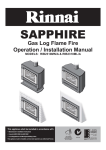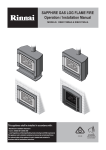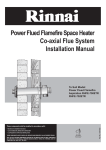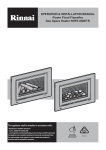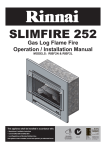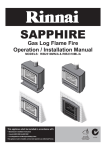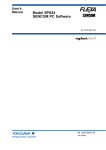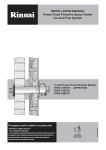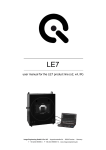Download Rinnai RIB2310MN Operating instructions
Transcript
SAPPHIRE /"0(0 !123!( &'( 4$ 5&%604!76&6!4869!%1!%1 This appliance shall be installed in accordance with: !" #$%#"# &'$$( ) #*+##$#), '#-. All Rinnai gas products are A.G.A. certified. Distributed and serviced in Australia under a Quality System certified as complying with ISO 9001 by SAI Global Congratulations on the purchase of your Rinnai Sapphire gas log flamefire. We trust you will have many years of comfort and enjoyment from your appliance. BEFORE PROCEEDING WITH THE OPERATION OR INSTALATION OF YOUR NEW REMOTE CONTROLLER PLEASE READ THIS MANUAL THOROUGHLY AND GAIN A FULL UNDERSTANDING OF THE REQUIREMENTS, FEATURES AND OPERATION OF YOUR NEW CONTROLLER. Rinnai Australia i Sapphire Controller Operation Manual TABLE OF CONTENTS SAFETY & CARE .................................................................................................................................................. 1 CONTROLLER SAFE HANDLING & CARE........................................................................................................ 1 BATTERY SAFETY & DISPOSAL INSTRUCTIONS........................................................................................... 1 REMOTE / THERMOSTATIC CONTROLLED OPERATION................................................................................ 2 REMOTE CONTROLLER - BATTERY INSTALLATION ..................................................................................... 3 REMOTE CONTROLLER - SYNCHRONISATION. ............................................................................................ 3 REMOTE CONTROLLER - MANUAL OPERATION ........................................................................................... 3 REMOTE CONTROLLER - AUTOMATIC OPERATION ..................................................................................... 4 WIRELESS CONTROLLER / THERMOSTAT..................................................................................................... 5 TO TURN YOUR HEATER ON WITH REMOTE / THERMOSTATIC CONTROL............................................... 7 MODES OF OPERATION ................................................................................................................................... 7 PROGRAMMING OF PROGRAM MODES......................................................................................................... 9 GENERAL OPERATION CHARACTERISTICS ............................................................................................... 11 TROUBLE SHOOTING CHECKLIST ................................................................................................................ 11 WARRANTY & PURCHASE RECORD............................................................................................................... 12 WARRANTY ...................................................................................................................................................... 12 PURCHASE RECORD ...................................................................................................................................... 12 CONTACT INFORMATION ................................................................................................................................. 13 CARTON CONTENTS Ensure that the components listed below are present before proceeding. 1 2 3 4 1 Wireless remote/thermostatic control 3 AA batteries (x2) 2 Wall mount 4 These Operating Instructions Rinnai Australia ii Sapphire Controller Operation Manual SAFETY & CARE CONTROLLER SAFE HANDLING & CARE • Clean your controller with a lightly dampened cloth; DO NOT use harsh abrasives or solvents to clean any part of the controller, doing so may result in damage to the finish of the controller. • DO NOT place your controller in a position where it may be easily damaged, i.e. on the floor or on a seat or under a heavy object. • DO NOT leave your controller in direct sunlight. • DO NOT expose your controller to excessive humidity or submerse it in fluid. • DO NOT carry your controller around in pants pockets or purse, risk of damage to the screen may occur. • DO NOT leave your controller on top of a free standing unit where it may be affected by the heat of an operating appliance. • DO NOT dismantle, or otherwise modify the controller, attempting to do so may damage or affect the operation and will void your warranty. BATTERY SAFETY & DISPOSAL INSTRUCTIONS Please follow the instructions below for safe handling and proper disposal of each type of your controller batteries. • DO read the instructions on packaging of batteries. Make sure to insert new batteries correctly, following the symbols for positioning the positive (+) and negative (-) ends of each battery. • DO replace batteries with the size and type specified in your Rinnai product's Operation / Installation manual. • Exchange both spent batteries from the controller at the same time, do not mix old and new batteries. • DO store batteries in a cool, dry place at normal room temperature. Remove batteries from devices that will be stored unused for extended periods. • DO dispose of batteries according to the local laws and regulations of your region. Some batteries may be recycled, and may be accepted for disposal at your local recycling centre. If you are not able to identify the applicable rules in your area, please check the instructions of the battery manufacturer. • Batteries may present a risk of fire, explosion, or chemical burn if mistreated. • DO NOT disassemble, puncture, modify, drop, throw, or cause other unnecessary shocks to batteries. • DO NOT dispose of batteries in a fire or incinerator, or leave batteries in hot places such as a car left in direct sunlight. • DO NOT store batteries near an oven, stove, or other heat source. • DO NOT connect batteries directly to an electrical source, such as a domestic power outlet or car power-point. • DO NOT place batteries into a microwave oven, or into any other high-pressure container. • DO NOT immerse batteries in water or otherwise get them wet. • DO NOT short circuit batteries; for example, do not carry loose batteries in a pocket or purse with other metal objects, which may inadvertently cause a battery to short circuit. • DO NOT use batteries, or charge rechargeable batteries, that appear to be leaking, discoloured, rusty, deformed; emit an odour; or are otherwise abnormal. Warranty does not cover damage caused to the controller by incorrect, damaged, or leaking batteries. • DO NOT touch leaking batteries directly; wear protective material to remove the batteries and dispose of them properly immediately. • DO NOT reverse the polarity (positive and negative terminals) of batteries. • DO NOT mix used and new batteries, or install used batteries in other equipment. • DO NOT charge non-rechargeable batteries, or use unspecified charging instructions or equipment for rechargeable batteries. • DO NOT continue to charge batteries beyond the specified time. • DO NOT give batteries to young children, or store batteries where children may access them. • DO NOT put batteries in mouth. If swallowed, contact physician or local poison control centre immediately. Rinnai Australia 1 Sapphire Controller Operation Manual REMOTE / THERMOSTATIC CONTROLLED OPERATION For further enhanced comfort and convenience the Sapphire heater can be both remotely and thermostatically controlled through the use of a wireless wall mountable controller / thermostat. The wireless controller / thermostat is an optional extra available through your Rinnai stockist. DISPLAY LAYOUT & FEATURES 5 3 6 1 Time of day with ‘AM’ or ‘PM’ display Displays time of the day in hours and minutes, ‘AM’ or ‘PM’. The time is displayed when the thermostat is ‘ON’ or ‘OFF’. 2 Day of the week Displays the current day of the week. The day is displayed when the thermostat is ‘ON’ or ‘OFF’. 3 Current Room temperature display Displays the current temperature. The temperature range is 7°C - 32°C. 4 Setting Temperature ‘SET’ display When the thermostat is ‘ON’, the programmed (set) temperature will be displayed. 5 Transmit indicator Indicates that the thermostat is transmitting to the receiver, the symbol will appear on the LCD for 1 sec. 6 Battery Low indicator Indicates when the battery power is below an acceptable level. 7 Automatic mode indicator Indicates if the thermostat is in automatic mode. 8 Program mode indicator Indicates that the thermostat is in programming mode. 9 Manual mode indicator Indicates if the thermostat is in manual mode. 10 Setting ‘UP’ Button Increase hours, minutes, day or temperature. 11 ‘OK’ Button Accepts the current function and advances to the next function. 12 ‘PWR’ (Power) Button Switches the thermostat ‘ON’ and ‘OFF’. To turn ‘ON’ press and release the ‘PWR’ and ‘OK’ Buttons at the same time this will turn the thermostat ‘ON’ to the most recently programmed working mode. 13 ‘A/M’ Button Toggles between automatic, manual and flame mode. 14 ‘T’ (Time) Button Initiates time and day of the week programming (must press and hold for 2 or more seconds when the thermostat is ‘OFF’). 15 Setting ‘DOWN’ Button Decrease hours, minutes, day or temperature. 16 ‘P’ (Program) Button Initiates the programming mode (must press and hold for 2 or more seconds when the thermostat is ‘OFF’). 17 Flame Indicator Indicates the flame setting. 17 4 1 2 7 with 9 8 UP A/M T OK P PWR DOWN BUTTON LAYOUT & FEATURES 10 11 UP A/M 13 14 15 T OK DOWN P PWR 12 16 The Flame symbol graphically indicates which of the 7 graduated settings between Low and High flame when the burner is on. In AUTO or MANUAL temperature mode, if the burner is OFF due to room temperature being reached the symbol will modulate UP and DOWN. This is to indicate that the unit is still ON even though there are no flames visible in the appliance. Rinnai Australia 2 Sapphire Controller Operation Manual REMOTE / THERMOSTATIC CONTROLLED OPERATION REMOTE CONTROLLER - BATTERY INSTALLATION Carefully remove the battery compartment cover panel from the rear of your controller hand-set and correctly insert the two AA batteries supplied ensuring '+' and '-' polarity is correct. When installing your batteries your remote control will display the 'Initial Set-up Screen'. The screen will display the following: • Current room temperature in °C • Default time setting of • Default day of the week setting ‘MO’ - Monday. When batteries are changed all settings other than synchronisation are lost and the controller will revert back to the 'Initial set -up screen'. NOTE Synchronisation must be carried out when a new controller has been purchased. The heater will not respond or operate to any function until synchronisation has been carried out. REMOTE CONTROLLER - SYNCHRONISATION. Before proceeding with synchronisation ensure that the gas and electricity are connected. NOTE Two controllers CAN NOT be used at the same time! Synchronisation of Controller & The Heater Step 1).Turn the power off at the power point for a minimum of 30 seconds, synchronisation will not be possible unless the minimum 30 seconds has been observed. a b Step 2).Ensure the remote control is turned OFF, to turn OFF press and release the ‘PWR’ button once. Step 3).Turn the power ON at the power point, the blue power operation indicator b on the push button control panel will flash once. The controller can now be synchronised with the heater. Step 4).On the controller in quick succession press the following sequence of buttons: ‘P’ > ‘T’ > ‘T’ > ‘UP’. NOTE The LCD display will show ‘L/C’ (Learn Code) for 2 seconds then return to the normal ‘OFF’ state display. The blue power operation indicator b on the push button control panel will flash once to indicate that synchronisation has been accepted. Synchronisation MUST BE performed within 30 seconds of the power being turned ON, if more than 30 seconds has elapsed repeat steps 1 through 3. To restore factory default settings With the thermostat ‘OFF’, press the following sequence of buttons ‘P’ > ‘T’ > ‘T’ > ‘DOWN’. REMOTE CONTROLLER - MANUAL OPERATION Turning ‘ON’ and ‘OFF’ Press ‘ON’/‘OFF’ button of the Push Button Control Panel a once the Power Indicator LED b , will illuminate blue. Press the ‘OK’ and ‘PWR’ button at the same time to turn ‘ON’/ ignite the heater. This is a safety feature to reduce the accidental activation of the heater. The unit first lights the pilot and then after a short period switches to the ‘HIGH’ flame setting. To turn ‘OFF’ press and release the ‘PWR’ button once. Changing the temperature The Sapphire has temperature increments of 1° which can be changed using the ‘UP’ and ‘DOWN’ buttons. The temperature control range is 7 - 32°C Change between Celsius - °C and Fahrenheit - °F The thermostat temperature display can be set to °C or °F. The default is °C. With the controller ‘OFF’, press the following sequence of buttons: ‘P’ > ‘T’ > ‘T’ ‘A/M’ to toggle between °C or °F. Change between manual, automatic and flame modes Press and release the ‘A/M’ button. Rinnai Australia 3 Sapphire Controller Operation Manual REMOTE / THERMOSTATIC CONTROLLED OPERATION REMOTE CONTROLLER - AUTOMATIC OPERATION Setting the Current Time and Day of the Week STEP 1 STEP 2 STEP 3 10 UP A/M T OK UP P PWR A/M DOWN UP OK T P PWR A/M T DOWN OK P PWR DOWN 11 14 15 Step 1. With the controller ‘OFF’, press and hold the ‘T’ button ‘HOUR’ and ‘AM or PM’ will flash. NOTE 14 for approximately 2 seconds. ‘TIME’, If no buttons are pressed within 10 seconds the display will revert back to 'Initial Set-Up Screen' retaining the last entered setting. Step 2. To select the hour push the ‘UP’ button 10 or ‘DOWN’ button 15 until the desired hour is chosen, note that AM or PM is chosen by cycling through the 12 hour range. Step 3. Press the ‘OK’ button will flash. 11 to enter the selected hour and AM or PM. ‘TIME’ + ‘MINUTES’ + ‘AM or PM’ STEP 5 STEP 4 STEP 6 STEP 7 10 10 UP UP A/M T OK P PWR A/M T OK UP P PWR A/M DOWN DOWN T OK UP P PWR A/M T DOWN 11 OK P PWR DOWN 11 15 15 Step 4. To select the minutes push the ‘UP’ button chosen. Step 5. Press the ‘OK’ button will flash. 11 11 or ‘DOWN’ button 15 until the desired minutes are to enter selected minutes, One of the days SU, MO, TU, WE, TH, FR or SA Step 6. To select the hour push the ‘UP’ button Step 7. Press the ‘OK’ button 10 10 or ‘DOWN’ button 15 until the desired day is chosen. to enter the selected day and to complete time and day setup. To adjust time for Daylight Saving time To adjust time or to adjust for daylight savings follow Steps 1 and 2 then press ‘OK’ button keep the minutes and the current day. NOTE 11 , three times to When changing batteries all settings will be lost and the controller will revert back to the 'Initial setup screen'. Re-setting of time, date and programming will be necessary. Rinnai Australia 4 Sapphire Controller Operation Manual REMOTE / THERMOSTATIC CONTROLLED OPERATION WIRELESS CONTROLLER / THERMOSTAT The wireless controller is designed to be wall mounted on a bracket, (bracket supplied with the controller), within 20m of the heater. The controller houses the thermostat which senses room temperature and communicates back to the Sapphire via Radio Frequency. The ideal position for the controller is: Controller Specifications • Away from direct sunlight. Battery: 2 x AA batteries. • Suitable distance away from the heater (not exceeding 20 metres). Battery Life: Approximately 12 months. • Ideally 1.5 m from the floor (approximately at chest height). Dimensions: Height: 140 mm, Width: 80 mm, Depth: 20 mm. • Away from possible drafts in the room. Additional information about Remote Thermostat Control Buttons Transmit Indicator Battery Indicator Indicates the thermostat is transmitting to the receiver, the symbol with appear on the LCD for 1 second. This symbol will flash when batteries need replacing. The thermostat will remain functional for approximately 5 days before shutting ‘off’. Re-programming of the controller will be required after battery replacement. Temperature Display Displays current temperature. °C is the default but °F is available. The temperature range is 7°C - 32°C (45°F - 90°F). Room Indicator or Set Indicator When the thermostat is ‘ON’ the programmed (set) temperature and the room temperature will be displayed. When the Flame mode is ‘ON’ the Flame setting F7 to F1 will be displayed. PWR + OK UP A/M T OK P PWR DOWN Switches the thermostat ‘ON’ and ‘OFF’. If thermostat is ‘OFF’, pressing and releasing the ‘PWR’ + ‘OK’ button will turn the thermostat on to the most recently selected working mode. T (Time) UP A/M T OK P PWR PWR Initiates the time and day of week programming, press and hold for 2 seconds. DOWN UP, DOWN & OK UP A/M T OK P PWR PWR DOWN ‘UP’ increase hours, minutes, day or temperature ‘OK’, accepts the current function and advances to the next function, ‘DOWN’, decrease hours, minutes, day or temperature. P (Program) UP A/M T OK P PWR PWR Initiates the programming mode, press and hold for 2 seconds. DOWN Rinnai Australia 5 Sapphire Controller Operation Manual REMOTE / THERMOSTATIC CONTROLLED OPERATION Additional information about Remote Thermostat Control Opertation Character Diagnostic Check. To check the display characters on the remote control turn the controller 'off' by pressing the 'PWR' button then press P - T - T - OK in rapid succession. UP UP A/M T OK P PWR A/M T OK P PWR DOWN DOWN The remote will then commence automatically cycling through all the display characters, finally displaying the full screen as shown below. This process takes approximately 20 seconds and does not affect any programming. 1 2 3 UP A/M T OK P PWR DOWN If any of the characters are not displayed contact your Rinnai stockist for a replacement controller. NOTE The Fan and Snowflake symbols displayed are not utilized in the operation of the Sapphire heater. Rinnai Australia 6 Sapphire Controller Operation Manual REMOTE / THERMOSTATIC CONTROLLED OPERATION TO TURN YOUR HEATER ON WITH REMOTE / THERMOSTATIC CONTROL BEFORE PROCEEDING ENSURE THE GAS AND ELECTRICITY ARE TURNED ON. NOTE When the heater is in the OFF/STANDBY condition (power supply connected and switched on) the blue LED Power Indicator will double flash. This is normal. However before remote / thermostatic control can be used the heater must be taken out of the OFF/STANDBY condition, do this as follows: Press ‘ON’/‘OFF’ button a once the electronic ignition sparker will be able to be heard. Step 1. The electronic ignition stops when the pilot flame has been established. The main burner then ignites off the pilot. Once the main burner has ignited the heater can the be operated by remote / thermostatic control. b d a c MODES OF OPERATION To Turn Remote ‘ON’ or ‘OFF’ STEP 1 STEP 2 UP A/M T OK UP P PWR A/M T DOWN OK P PWR DOWN 11 12 12 Step 1. To turn ‘ON’ - press and release the ‘OK’ button 11 and ‘PWR’ button display will now include the setting temperature and the mode of operation. Step 2. To turn ‘OFF’ - press the ‘PWR’ button 12 12 at the same time. The only. Manual Temperature Mode • Temperature can be set at any level. • Time and day of week does not need to be programmed to operate. STEP 1 STEP 2 10 UP A/M UP OK T P PWR A/M DOWN T OK P PWR DOWN 13 15 Step 1. With the controller turned ‘ON’, press and release the ‘A/M’ button appears on the LCD. Step 2. Press press the ‘UP’ button increments of 1°C. Rinnai Australia 10 or ‘DOWN’ button 7 15 13 until the word ‘MANUAL’ to increase or decrease the temperature in Sapphire Controller Operation Manual REMOTE / THERMOSTATIC CONTROLLED OPERATION Automatic Timer Mode • In automatic timer mode temperature is regulated to the programmed level and time. • Time and day of week MUST BE set. STEP 1 STEP 2 10 UP A/M T UP OK P PWR A/M T DOWN OK P PWR DOWN 13 15 Step 1. With the controller turned ‘ON’, press and release the ‘A/M’ button on the LCD. Step 2. At any time press the ‘UP’ button increments of 1°C. 10 or ‘DOWN’ button 13 until the word ‘AUTO’ appears to increase or decrease the temperature in 15 Flame Mode • Temperature control is over ridden and the flame size can be set to any setting from F7 highest to F1 lowest. NOTE • When the fire first ignites it remains on highest flame for the first 60 seconds before changing to the selected flame height. Time and day of week does not need to be programmed. STEP 1 STEP 2 17 17 10 UP A/M T OK UP P PWR A/M DOWN T OK P DOWN 13 15 Step 1. With the controller turned ‘ON’, press and release the ‘A/M’ button and the flame symbol Step 2. Press the ‘UP’ button PWR 17 10 13 until the letter ‘F’ with a number appear on the LCD panel. or ‘DOWN’ button 15 to increase or decrease the flame height. The fan speed automatically adjusts to the corresponding flame height. It is not able to be selected by the operator. See the flame table below for flame height to fan speed relationship. NOTE Flame Height 1 2 3 4 5 6 7 Fan Speed HIGH LOW LOW LOW HIGH HIGH HIGH Manually Overriding The Set Program At any time, the temperature or fan speed may be adjusted ‘UP’ or ‘DOWN’ similarly to operating in “Manual Temperature Mode” on page 7. NOTE However, whenever the thermostat changes to a new time period, the temperature will be set automatically according to that period’s setting. Rinnai Australia 8 Sapphire Controller Operation Manual REMOTE / THERMOSTATIC CONTROLLED OPERATION Flame Height And Fan Speed The flame height and fan speed are not individually adjustable. Flame height and fan speeds are selected by the microprocessor according to the difference between the set temperature and the ambient temperature of the room. The fan speed automatically adjusts to the corresponding flame height. The fan speed is not able to be selected by the operator. When the heater is operated in ‘Manual Temperature Mode’ the flame height is automatically selected by the microprocessor to achieve and maintain the ‘set’ temperature. As an example, if the room is much colder than the ‘set’ temperature, the flame height and corresponding fan speed will be high. As the room heats up and gets close to the ‘set’ temperature the flame height and corresponding fan speed will revert to lower settings. When the heater is operated in ‘Flame Mode’ the flame height is set by the operator. Flashing Small Flame Symbol ‘on’ The small flashing flame symbol 17 on the RF controller display indicates the room temperature is within 0.5°C of set temperature. 17 Program Modes The appliance can be programmed to operate during four separate periods in one day, resulting in a possible 28 operating periods per week. A weekday program can be set so the program is used Monday to Friday. Similarly, a weekend program can be set for Saturday to Sunday. The entire week can also have the same program. If you do nothing to change the programming the following default settings would be available if you set it to automatic mode. Time Period Start Time Temperature °C Suggested Time Period Settings Period 1 6:00 am 20°C - Morning Period 2 8:30 am 15°C - Day time Period 3 5:00 pm 21°C - Evening Period 4 10.30 pm 15°C - Night time To revert back to the default settings once you have reset the periods, in rapid succession press the following sequence of buttons ‘P’ - ‘T’ - ‘T’ - ‘DOWN’. Factory default settings PROGRAMMING OF PROGRAM MODES STEP 1 STEP 2 STEP 3 10 UP A/M T OK DOWN UP P PWR A/M 16 T OK DOWN 15 UP P PWR A/M T OK DOWN P PWR 11 Step 1. With the controller ‘OFF’, press and hold the ‘P’ button 16 for approximately 2 seconds. The LCD will display ‘PROG’. ‘Pd’ and the current time and the day ‘MO’ will flash. Step 2. To select the day range press the ‘UP’ button 10 or ‘DOWN’ button 15 until the desired day range has been chosen the day ranges are as follows: MO TU WE TH FR MO TU WE TH FR SA SU SU - SA SU MO TU WE TH FR SA Holding the ‘UP’ or ‘DOWN’ buttons for more than 2 seconds will scroll through the day ranges. NOTE Rinnai Australia 9 Sapphire Controller Operation Manual REMOTE / THERMOSTATIC CONTROLLED OPERATION STEP 4 STEP 6 STEP 5 10 10 UP A/M T OK UP P PWR A/M T DOWN OK UP P PWR DOWN A/M 15 OK T P PWR DOWN 16 15 Step 3. Press the ‘OK’ button 11 to enter the selected day range. The LCD will display ‘PROG’. ‘P1’ and the ‘TIME’ + ‘HOUR’ + ‘AM’ will flash. Step 4. To select the ‘ON’ hour for ‘P1’ push the ‘UP’ button 10 or ‘DOWN’ button 15 until the desired hour is chosen, note that AM or PM is chosen by cycling through the 12 hour range. Step 5. Press the ‘OK’ button will flash. 11 to enter the selected hour and AM or PM. ‘TIME’ + ‘MINUTES’ + ‘AM or PM’ Step 6. To select the ‘ON’ minutes for ‘P1’ push the ‘UP’ button minute is chosen. STEP 7 10 or ‘DOWN’ button STEP 8 until the desired 15 STEP 9 10 UP A/M T OK UP P PWR DOWN A/M 16 T OK UP P PWR A/M DOWN T OK P DOWN 15 Step 7. Press the ‘OK’ button 11 PWR 16 to enter the ‘ON’ minutes. ‘SET’ + ‘TEMPERATUTRE DIGITS’ will flash. Step 8. To select the ‘ON’ temperature for ‘P1’ push the ‘UP’ button temperature is chosen. 10 or ‘DOWN’ button 15 until the desired Step 9. Press the ‘OK’ button 11 to enter the selected temperature. The LCD will display ‘PROG’. ‘P2’ and the ‘TIME’ + ‘HOUR’ + ‘AM’ will flash, this completes the programming for the ‘P1 - ON’ period. Repeat steps 3 through 9 for ‘PROG’. ‘P2 - OFF’, ‘P3 - ON’ and ‘P4’ ‘OFF’ periods. Rinnai Australia 10 Sapphire Controller Operation Manual TROUBLE SHOOTING GENERAL OPERATION CHARACTERISTICS NOTE Before asking for a service call please check the following table as these characteristics are part of the normal operation of the appliance and do not indicate a fault. CHARACTERISTIC EXPLANATION At ignition: Warm air does not start when the burner lights. The fan is started automatically after a short delay. This is to allow the heat exchanger to warm up, helping to avoid cold draughts. This is normal operation. Smoke or strange smells are produced on the first start up after installation. This is caused by grease, oil or dust on the heat exchanger. This is to be expected and will cease after a short time. Sharp clicking noises at ignition, or when the unit thermostat modulates to a lower or higher setting, or shuts down. This is simply expansion and contraction noise from the heat exchanger. This is a normal operation sound. During combustion: Dull clunking noise when the thermostat operates. This is the sound of the solenoid gas valves opening and closing to regulate the gas flow. These are normal operation noises. When the appliance is turned off: Convection fan continues to run after turning ‘OFF’. This is to remove residual heat from the heat exchanger and stops once the appliance cools sufficiently. TROUBLE SHOOTING CHECKLIST Not plugged in or turned off Mains power failure (Initial Install) Air in gas pipe Air in hose Ignition failure Flat battery for remote control Gas supply turned off Gas escape Inadequate flue system Insufficient gas pressure Log Misalignment Normal operation *Remote not working Fault Condition Simplest Possible Remedy Plug in power cord and turn power ‘ON’. Re-ignition, when power restored. Installer to purge air from gas supply. Repeat Ignition procedure. Repeat Ignition procedure. Replace remote control battery. Turn gas supply on at the meter or cylinder. Isolate gas supply, call Rinnai. Call Rinnai. Call Rinnai. Call Rinnai. No action is required. Fan not working - fan automatically comes on after 4 minutes not heat switch activated. Allow heater to warm up. Allow heater to run on high for 4 minutes. Call Rinnai. Replace batteries. Refer to page 9 for solution. Refer to page 11 for solution. * Normal operation Normal operation Heat switch not activated Possible fan fault Controller display blank Control Panel Operation Controller Not Synchronised ** * Only applicable when optional remote controller is used. Rinnai Australia Glass, Streaky lines Glass, Condensating Severe sooting Minor soot deposits Fan Not Working Probable Cause Smell of gas Fault Condition Burners fail to ignite Use the following chart to help determine whether a service call is required, however if you are unsure about the way your heater is operating, contact Rinnai or your local agent. ** Only applicable if the remote controller is programmed. 11 Sapphire Controller Operation Manual WARRANTY & PURCHASE RECORD WARRANTY Warranty does not cover damage caused to the controller by; incorrect, damaged, or leaking batteries. For full warranty terms and conditions for you remote controller / thermostat refer to the warranty booklet supplied with your Rinnai Sapphire heater. THE ORIGINAL RECEIPT MUST BE RETAINED AS PROOF OF PURCHASE. NOTE PURCHASE RECORD Purchased From Company Name: ____________________________________________________________________ Company Address: ____________________________________________________________________ ____________________________________________________________________ ____________________________________________________________________ Telephone: ____________________________________________________________________ Mobile Phone: ____________________________________________________________________ Purchase Date: ____________________________________________________________________ Rinnai Australia 12 Sapphire Controller Operation Manual CONTACT INFORMATION Australia Pty. Ltd. Internet: www.rinnai.com.au E-mail: [email protected] ABN 74 005 138 769 Head Office National Help Lines 10-11 Walker Street, Braeside, Victoria 3195 P.O. Box 460 Tel: (03) 9271 6625 Fax: (03) 9271 6622 Sales & Service Tel: 1300 555 545* Fax: 1300 555 655* *Cost of a local call Higher from mobile or public phones. Rinnai has a Service and Spare Parts network with personnel who are fully trained and equipped to give the best service on your Rinnai appliance. If your appliance requires service, please call our Help Line. Rinnai recommends that this appliance be serviced every 2 years. RNZ 11979 Issue D 13 RA 2010_013RIB2310CONTROL, Issue 4 - 5/9/11
















